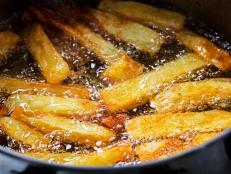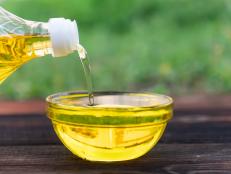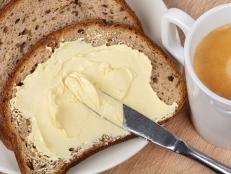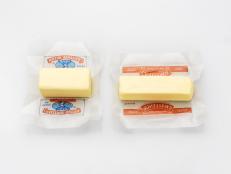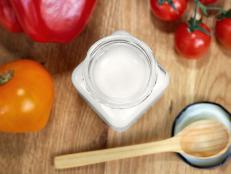Best Oil for Frying
The 6 best oils for frying, ranked. Plus which oils to never use.
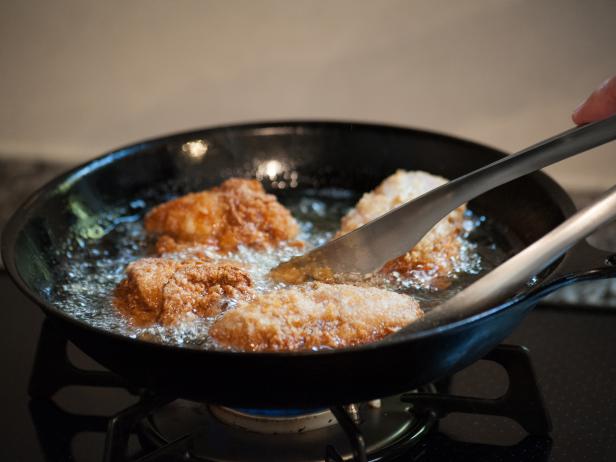
moriyu/Getty Images
By Dana Beninati
Dana is a host, chef and sommelier.
Are you overwhelmed by the large array of oils lining grocery store shelves? Since when does oil come from avocados anyway? When deep frying at home, proper oil selection can make or break the success of your dish. You want to make sure you get it right, and we’re here for you. Read on to learn the distinctions between various types of oil and what makes the ideal frying oil.

RalucaHotupan/Getty Images
Best Oil for Frying (Ranked by Types of Oils)
Oil for frying should have three qualities. First, it should be neutral in flavor, second, it should be affordable and third, it should have a high “smoke point”.
Think of the oil you fry in as part of the cooking method, rather than an ingredient that imparts flavor. Good frying oil is entirely flavorless, so it doesn’t compete with the flavor of the food being fried.
For best results when frying, food should be fully submerged in hot oil – hence the term “deep” fat frying. This explains why it is essential to pick an affordable oil, because you need a lot of it to fry properly.
Now what is smoke point you ask? Think of it like a temperature cliff - go over it and the oil will burn, creating bitter flavors in your food and danger in your kitchen. A neat visual cue to tell when an oil reaches its smoke point: it’ll stop shimmering. The smoke point of oil falls anywhere between 325 degrees F and 525 degrees F, depending on the source of the oil. That’s a wide range. Remember that deep fat frying generally demands a temperature of 350 degrees or higher. This means you should fry in an oil with a smoke point of at least 400 degrees, as all the oils listed below have.
1. Corn Oil
Pros: Most affordable and accessible oil on the market, high smoke point.
Cons: Void of nutritional value.
2. Blended Oil (aka Vegetable Oil)
Pros: Easy to find and economical, combines the advantages of multiple plant-based oils.
Cons: Wide variation between brands, so smoke points can be unpredictable.
3. Plant Oils (Canola, Sunflower, Cottonseed, Safflower)
Pros: Fairly high smoke points across the board.
Cons: May contain allergens that are not clearly stated on the front label.
4. Peanut Oil
Pros: Very affordable and lasts a long time.
Cons: Peanuts are a common allergen.
5. Avocado Oil
Pros: The highest smoke point and nutritional value available.
Cons: It’s expensive and sold in small bottles.
6. Coconut Oil
Pros: Can offer some health benefits.
Cons: Low smoke point, especially when unrefined, and high in saturated fats.
Is Olive Oil Good for Frying?
Olive oil is disqualified from our line-up of potential frying oils because it does not have the three qualities we look for when frying. Instead of being flavorless, olive oil has a beautifully robust flavor. It is also significantly higher in price than most of the oils listed above. Moreover, and perhaps the biggest strike against olive oil, is the fact that it has a low smoke point of 325 degrees F, making it fragile and easy to burn. If a recipe says to fry in olive oil, try blending it with a more stable and neutral option like corn oil.
What Is the Healthiest Oil for Frying?
While frying is not synonymous with healthy cooking, the type of oil used when frying can in fact make a difference. Avocado oil contains large quantities of Omega-9 and Omega-3 fatty acids and is particularly high in oleic acid. Unsaturated fatty acids like these have been shown to lower bad cholesterol and the risk of heart disease. This makes avocado oil the healthiest choice when frying. We love to substitute avocado oil in recipes with longer cook times, like Fried Chicken.
Best Oil for Air Fryer
Think of an air fryer like a mini oven with a concentrated supply of heat, which is released very close to the food being cooked. Because of this, the smoke point of oil becomes even more important when air frying. To ensure even browning, without burning, spray oils are the best for the job. Most of the oils we described above come in spray bottle form and you can scoop them up at any supermarket. Also, you can convert any oil into a spray with this handy gadget. Put it to the test with these delicious Coconut Shrimp.
What To Do with Oil After Frying
Most importantly, oil should be completely cool before being handled or discard. If reusing the oil, strain through a fine mesh sieve and discard any particles or debris - more on this later! If disposing of the oil, pour into a sealable (and ideally recycled) container like an old coffee canister and discard. Some cities may also offer collection sites for recycling used oil – check for one near you here.
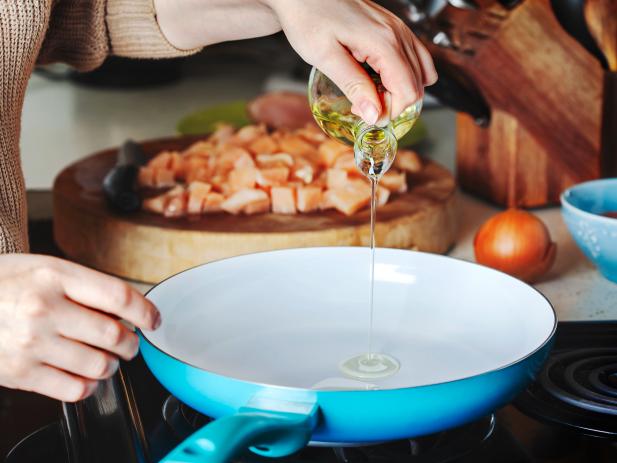
Anjelika Gretskaia/Getty Images
Frying Tips & Tricks
- Used oil performs better than fresh when frying. Instead of discarding cooled frying oil, strain out any debris and store the oil for future use in an airtight container. This is precisely what restaurants do to create consistently golden brown treats and control costs. But how do you know when your oil is truly spent? Any off odors or changes in the color and clarity are indicators that it is time to change the oil. Dispose of the oil at this point and start fresh.
- Gather the proper equipment. We recommend heavy bottomed pots with high sides like this one. We often reach for cast iron pots for their even heat distribution and steady maintenance of temperature. Whenever you add food into hot oil it will lower the temperature, so you need to monitor the temperature or adjust the heat. This makes an instant read thermometer essential, especially when frying in batches, like with Fish and Chips.
- Avoid labels that read “unrefined, virgin, or extra virgin.” These terms describe oils with low smoking points that will burn easily.
- Check out our deep frying guide. For step-by-step deep frying instructions, head over to our deep frying guide.
Related Links:
























